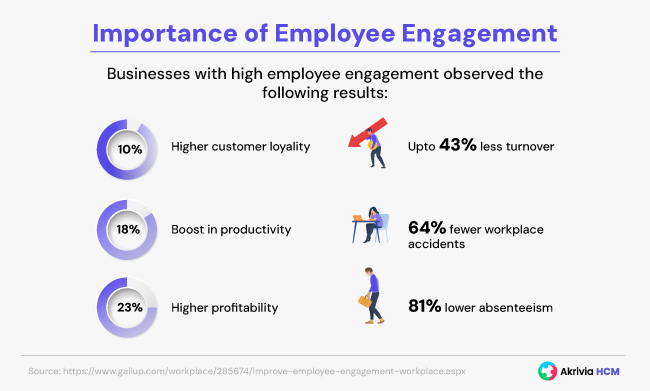Introduction
According to the State of the Global Workplace 2023 report by Gallup, 59% of employees globally are quiet quitting.
With the Great Resignation 2020-21 as the forerunner, quiet quitting and coffee badging have now become the latest trending phenomenon. While the Big Quit was about employees voluntarily quitting their jobs once and for all, quiet quitting and coffee badging is about employees losing interest and quitting their jobs on an everyday basis.
In this blog we will discuss the results of decreased or no employee engagement and what you can do to increase the employee engagement rates at your organizations.
What Happens When There is a Lack of Employee Engagement?
An employee is considered to be engaged when they feel a sense of belonging and attachment to their organization. An engaged employee is more productive and willing to work towards fulfilment of company goals. On the other hand, an employee who is disengaged is actually the one who is just a couple of steps away from quitting your organization altogether.
Disengaged employees is a huge cost that companies end up bearing, often resulting in decreased employee retention and increased employee turnover. Lack of engagement can easily lead to a lack of motivation among employees thereby negatively impacting on your profit margins.
In terms of pop culture workplace jargon, quiet quitting and coffee badging are the two latest outcomes of low and lack of employee engagement.
What is Quiet Quitting?
Often used as an alternative, but quiet quitting is actually different from employees handing over their resignation letters. It happens when employees are only completing tasks that are mentioned in their job descriptions. An employee who is quiet quitting is working the bare minimum only for the paycheck. They do not feel attached to their organization enough to feel motivated to go above and beyond or contribute their best at work.
There are constant ongoing controversies when it comes to quiet quitting, regarding if it’s really a problem when employees start to draw a line to achieve a work life balance. While setting boundaries can be healthy but it is equally important to evaluate the reasons that has led to it. This is when it becomes a concern!
If your employees are voluntarily choosing to limit their potential at work, it may be time for you to review your own HR policies. The working environment and organizational culture can highly impact the productivity and satisfaction level of your employees.
An environment lacking flexibility and employee listening can lead to a sense of aversion among employees towards their workplace which can then lead to what we today call coffee badging.
What is Coffee Badging?
With offices mailing the return-to-office policy, employees are now scared of losing their autonomy and family time. As a result of being forced to physically show-up at the office, they are now opting for coffee badging as a coping mechanism.
Coffee badging takes place when your employees arrive at work for a couple of hours only to socialize with their coworkers over a cup of coffee and leave immediately after, without actually sitting down to get work down. Coffee badgers prefer to complete their work after they go back home. This practice essentially leads to a wastage of the working hours.
Coffee badging is more prevalent among hybrid workers, where physical presence of employees is mandatory for a fixed number of days in a week or month. The ease and flexibility of working from home is a comfort that employees are not willing to give up.
According to a survey conducted by Owl Labs, 47% of employees are even ready to quit willingly if they are forced to return-to-work.
Coffee badgers usually find working from home more productive due to minimized distractions and the unnecessary wastage of time on commuting to and back from the office. They prioritize timely completion of work over physical presence in the office.
Both quiet quitting and coffee badging highlight the importance of building a workplace where employees are trusted, communication is open, and flexibility is allowed to them. In order to achieve these, it is important for employers to keep their employee engagement levels high. When employees feel engaged, they do not feel decisions are being imposed upon them.

How to improve Employee Engagement?
“You can have the best services and best team, but if you don’t have engaged and enthused employees it won’t matter,”
– Maryanne McWhirter, Sr. Inbound Marketing and Sales Consultant, LeadG2.
The performance of employees is the driving force behind smooth business operations. However, this gets directly affected when employees do not feel engaged enough with their organizational goals, culture and values. Just as it is important to consider the needs and wants of the customer for a successful brand image, it is equally important to take into account the needs and desires of your employees for an effective employer brand image and overall business success.
8 Effective Techniques to Improve Employee Engagement at Your Workplace
- Identifying Burnout Symptoms
- Facilitating Open Communication
- Building Trust
- Investing in Learning and Development
- Rewards and Recognitions
- Prioritizing Performance Over Physical Presence
- Empowering Leaders
- Building a Culture of Belonging and Growth
1. Identifying Burnout Symptoms
As the famous saying goes, ‘prevention is better than cure’; it’s best to identify the symptoms of burnout before they turn into quiet quitting or coffee badging. Try to find out the factors which may be demotivating your employees. Review your policies; company culture; the type of leadership approach prevalent, the availability of career growth.
2. Facilitating Open Communication
Create an environment where employees can openly communicate to you the issues that need attention. Use tools like anonymous employee satisfaction surveys embedded in your HCM to gain a clear understanding of employee perspective. Be open to taking feedback from your employees and schedule one-on-one sessions at regular intervals encouraging open and clear communication.
3. Building Trust
Being trusted, respected and valued are 3 intangible assets that every employee intends to achieve at their workplace. Provide enough autonomy and resources to your employees so that they feel empowered enough to make decisions related to their work. This practice develops a greater sense of ownership, connection and fulfilment. This way employees are more open to contributing towards creating an impact and achieving the organizational goals.
4. Investing in Learning and Development
Quiet quitting can be an outcome of repetitive work, boredom and a lack of a concrete career path. Well planned learning and development programs tailored as per the interests and needs of individual employees can go a long way in reviving the interests of your employees. When employees are provided adequate support by an organization for charting a career growth plan, they feel valued and more inclined towards going beyond the usual.
5. Rewards and Recognitions
When employees are not regularly acknowledged for the extra hours and efforts they put in at work, they start to lose interest in going above and beyond. Lack of appreciation and recognition can lead to a decrease in the productivity levels of employees. The best way to tackle this is using a performance management system that can automatically help you with recognizing the hard work and timely rewarding the employees.
6. Prioritizing Performance Over Physical Presence
Coffee badging is a clear example of what may happen when being physically present at the office is given higher importance over outcomes. When employees start to feel that sticking to completion of allotted working hours is enough for their paycheck, the quality of work they produce decreases significantly. The best way to avoid this is to focus on setting clear goals and establishing with your employees how their contribution impacts on the business’s success.
7. Empowering Leaders
A manager plays a huge role in shaping the work environment for your employees. Empower your leaders with empathy, knowledge and resources so they can put their best foot forward when managing teams. Collect feedback and suggestions from them to understand better the needs of your employees and how you can improve productivity. Equip managers with the essential tools that they might need for better management decisions.
8. Building a Culture of Belonging and Growth
Focus on building such an organizational culture where employees don’t have to be or feel forced, but they willingly decide to join you at the office. Acknowledge diversity and differences to facilitate development of meaningful relationships that go beyond professional and a more inclusive environment. Creating a positive and thriving culture is the most sustainable method for ensuring long term employee retention and productivity.
Conclusion
Employee engagement should become a part of your business strategy. This will ensure that as an employer you are making your people feel heard and emphasizing the importance of employee engagement as an essential metric to measure employee productivity.
An engaged workforce serves as a flagbearer for an organization’s sustainable success. And now it’s time for you to take the next step towards putting employee engagement into everyday practice.
Employee engagement practice is now made easy with the evolution of modern day HCM solutions. Schedule a demo session and check out how our employee engagement module can transform your HR operations.




